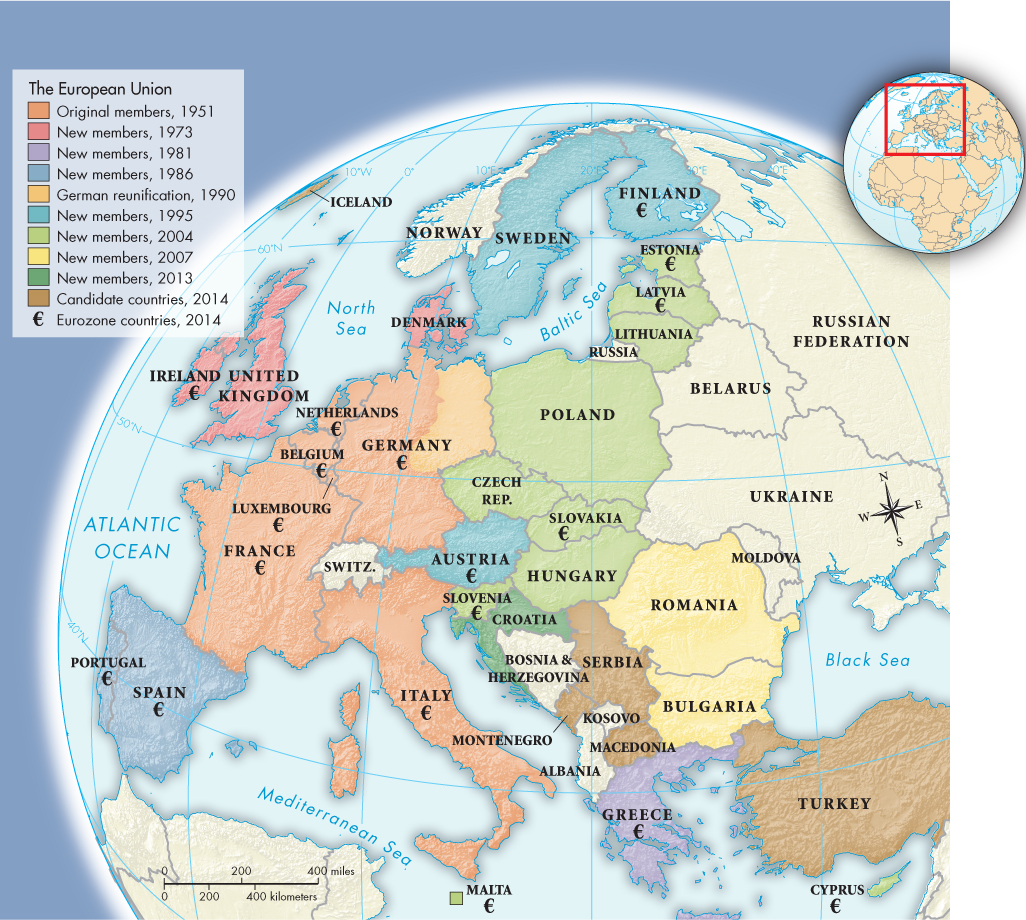A History of World Societies:
Printed Page 1022
A History of World Societies Value
Edition: Printed Page 1037
Integration and Reform in Europe
Building on integration efforts in the 1940s and 1950s established through NATO and the Common Market (see “Western Europe’s Postwar Challenge” in Chapter 31), at the end of the twentieth century European nations moved toward greater unity. With military and trade integration in place, France and Germany took the lead in pushing for a monetary union among Common Market members. The European Union (EU), established in 1993, allowed for the free movement of people and goods among its original twelve member countries; created a common currency, the euro (2002); and formed a European Parliament that established regulations and pooled infrastructure and education investments. This integration was a response to the Cold War, and it provided a logic for rebuilding a continent that had devastated itself through two world wars and wished to avoid another. But it was also a response to the end of European overseas empires.
The loss by western European countries of their colonies in Africa and Asia was a major incentive to unify within Europe because it dramatically shifted their access to markets and resources. For five centuries overseas empires not only provided the engine for economic development at home but also shaped international relations as well as intellectual currents ranging from abolitionism to scientific racism and even Marxism. Empires provided raw materials and markets that produced industrialization. For France, colonies in the Mediterranean, Africa, and Southeast Asia served, at least in principle, as a counterweight to Germany’s might. Empires in Africa and Asia allowed Britain and Portugal to remain “proudly alone,” in the words of Portuguese dictator Salazar.6 As the cycle of colonialism ended, nations that had related to each other with the crutch of overseas empires now needed to forge new relationships directly with one another — the first time they had ever done so since the cycle of colonialism accompanied the process of nation-
For eastern Europe, integration with western European countries was a means of ending Soviet domination. As the Cold War barriers between eastern and western Europe fell after 1989, eastern European countries became some of the most avid participants in the process of economic and institutional integration. Much as integration created the logic for rebuilding Germany and reimagining nations without empires attached to them, European economic integration provided a blueprint for reforming economies and institutions in countries transitioning away from Soviet models, and the collapse of Communist regimes brought the apparent triumph of liberal democracy. For the first time since before the French Revolution, almost all of Europe followed the same general political model.
European leaders embraced, or at least accepted, a neoliberal, free-
In the 1990s Germany and France continued to lead the push for integration. French president François Mitterrand (1916–
The success of the euro encouraged the EU to accelerate plans for an ambitious enlargement to the east. On May 1, 2004, the EU started admitting eastern European countries. By 2007 the European Union had twenty-

The movement toward union raised profound questions about the meaning of European unity and identity. Would the EU remain an exclusive Western club, or would it expand to include the postcommunist nations of eastern Europe? If some of them were included, how could Turkey, a secular nation with a Muslim majority, be denied its long-
A proposed EU constitution binding EU member states even closer together was scheduled to go into effect in 2007. First, however, it needed to be approved by voters in all member countries. In 2005 voters in France and Holland voted overwhelmingly against the constitution and threw the entire process into confusion. The rejected constitution was replaced with the Treaty of Lisbon in 2007. The new treaty kept most of the reforms contained in the original European constitution, but it revised the political structure of the EU bureaucracy. By November 2009 all members had approved it, and the Lisbon treaty came into force on December 1, 2009, unifying what had been a profoundly divided, war-
The economic crisis that began in 2008 tested the European Union and the euro. Countries that had adopted the euro currency had to meet stringent fiscal standards and imposed budget cuts and financial austerity. The resulting reductions in health care and social benefits hit ordinary citizens hard. A global economic recession magnified these difficulties. National governments could no longer expand their own monetary supplies to promote recovery, and governments were forced to slash budgets to meet debt obligations. Economic austerity brought ruinous economic cycles that crippled Greece, Portugal, Spain, and Italy. The consequences of liberalization in Europe resembled the consequences elsewhere: economic growth was greater, but economic hardships were deeper.